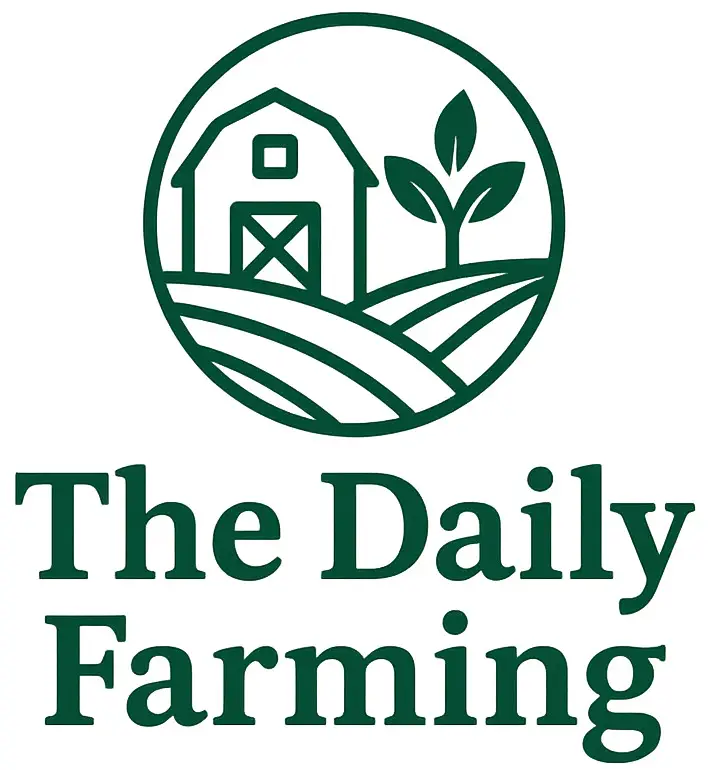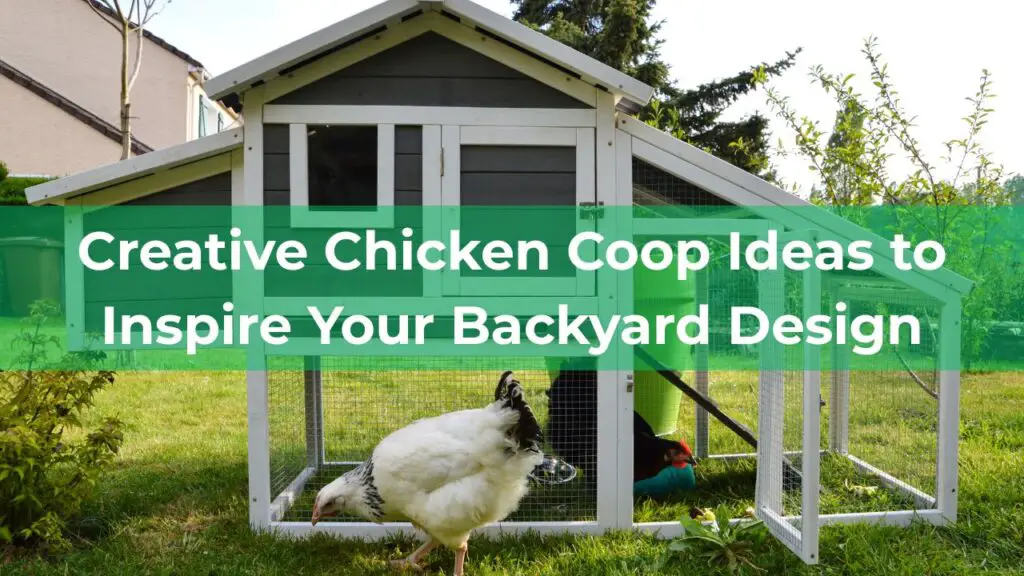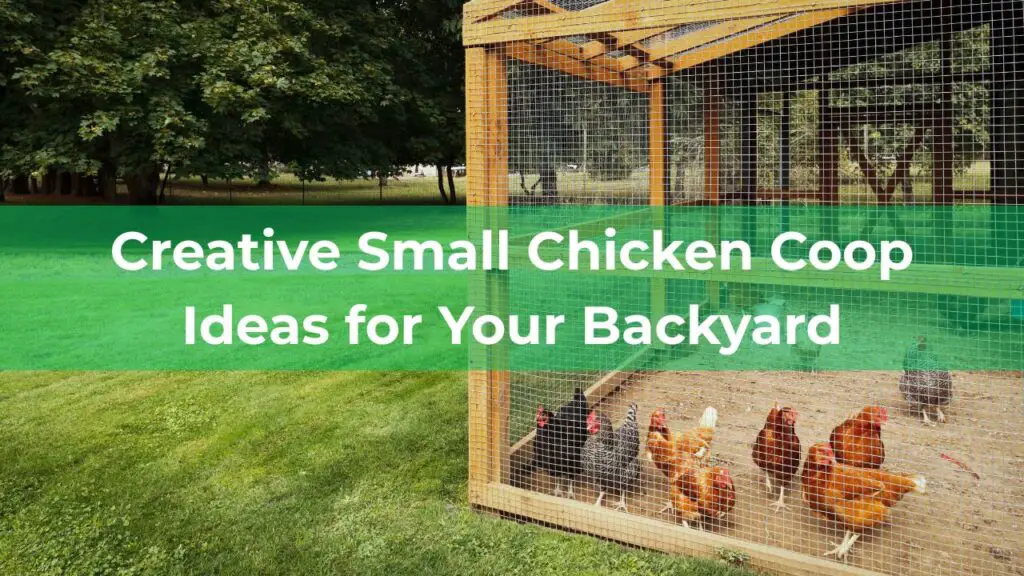Raised garden beds are a fantastic way to elevate your gardening game! They not only provide better drainage and soil quality but also make gardening more accessible and enjoyable. Perfect for growing vegetables, herbs, and flowers, these beds can be customized to fit any space and style, turning your yard into a productive oasis with ease.
Choosing the Right Location
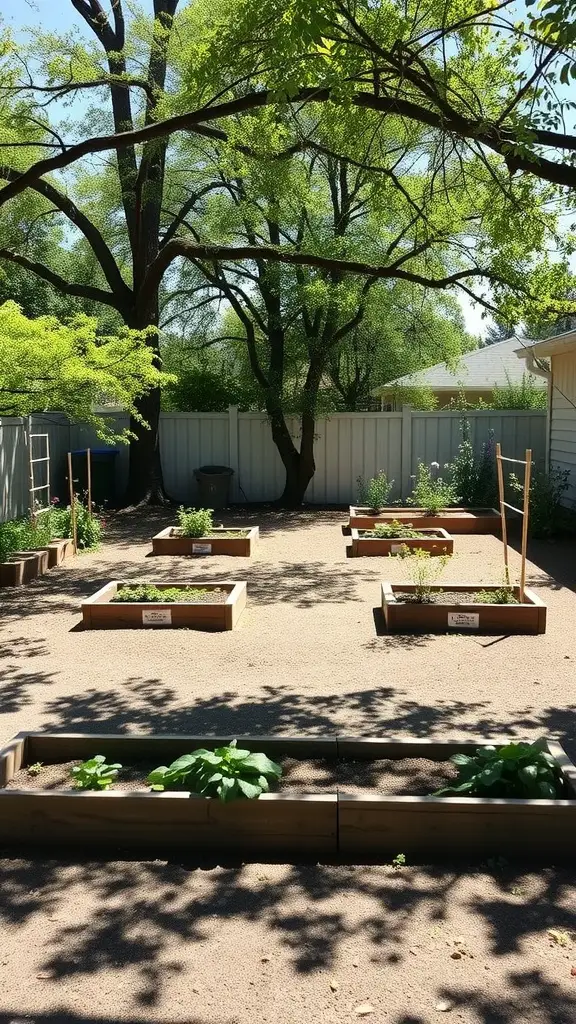
When setting up raised garden beds, picking the right spot is key. The image shows a lovely garden area with multiple raised beds, surrounded by trees and a cozy atmosphere. This setup highlights how location can enhance your gardening experience.
First, think about sunlight. Most plants need at least six hours of direct sunlight daily. In the image, the trees provide some shade, which can be great for certain plants but may hinder others. Observe how the sun moves across your space throughout the day.
Next, consider accessibility. You want to make sure you can easily reach your garden beds for planting, watering, and harvesting. The layout in the image allows for easy movement between the beds, making gardening tasks simpler.
Lastly, think about water drainage. Raised beds typically need good drainage to prevent waterlogging. The gravel surface in the image suggests good drainage, which is essential for healthy plants. Ensure your chosen location has proper drainage to keep your garden thriving.
Soil Composition for Optimal Growth
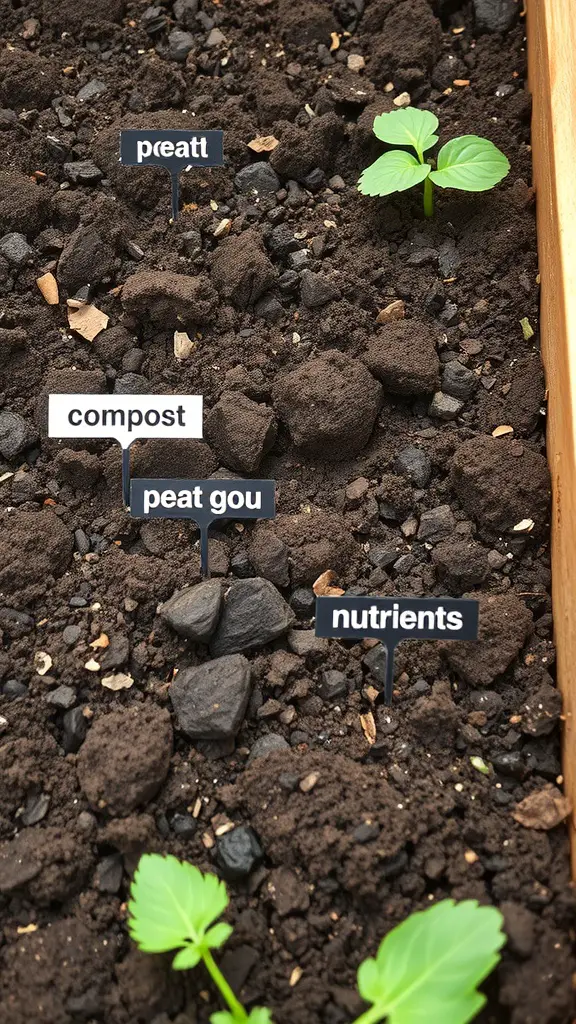
Creating a thriving raised garden bed starts with understanding the soil composition. The image shows a rich, dark soil filled with essential components for plant growth. Key elements like peat, compost, and nutrients are highlighted, showing their importance in nurturing plants.
Peat helps retain moisture while providing aeration. It’s lightweight and improves soil structure, making it easier for roots to grow. Compost adds organic matter, enriching the soil with vital nutrients. It also enhances microbial activity, which is crucial for a healthy ecosystem in your garden.
Nutrients are the building blocks for plant health. They support growth, flowering, and fruiting. A balanced mix of these elements ensures that your plants get what they need to thrive. By focusing on these components, you can create an environment where your plants can flourish.
Seasonal Planting Guide
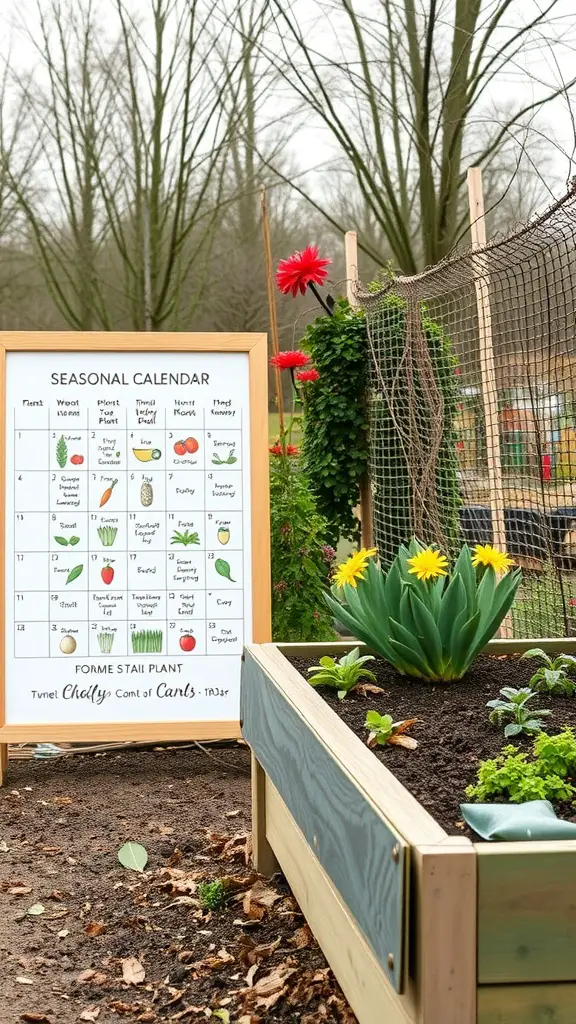
Raised garden beds are a fantastic way to grow your own plants, and knowing when to plant is key. The image shows a seasonal calendar that helps you decide what to plant and when. This calendar is a handy tool for both beginners and seasoned gardeners.
In the image, you can see a chart that lists various plants alongside the best times to sow them. It’s organized clearly, making it easy to follow. For example, you might find that certain vegetables thrive in spring, while others do better in the fall.
Having a visual guide like this can take the guesswork out of gardening. You can plan your planting schedule around the seasons, ensuring that your raised beds are always filled with healthy plants. Plus, it’s satisfying to see your garden flourish throughout the year!
Benefits of Raised Garden Beds
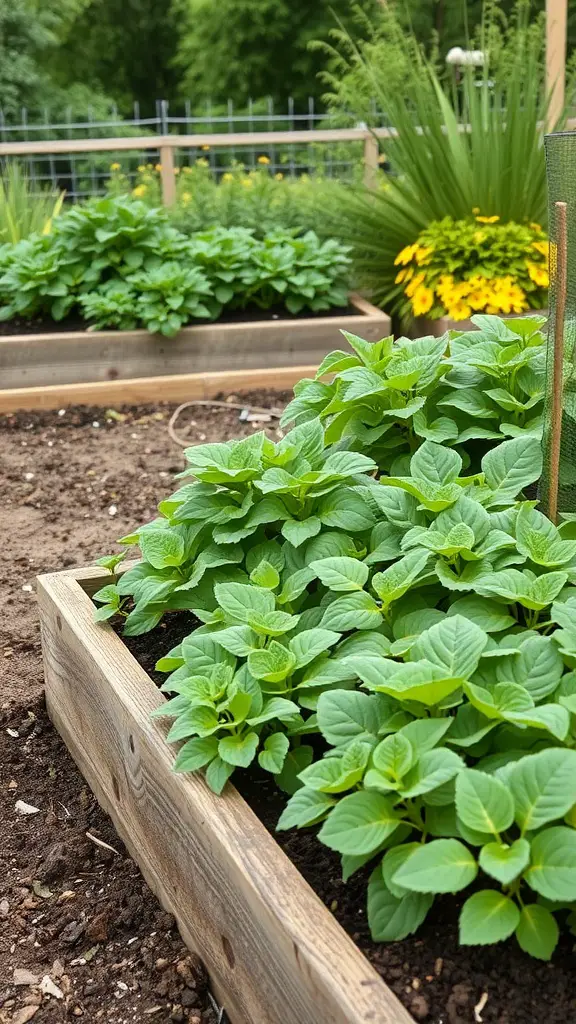
Raised garden beds are a fantastic way to grow plants, and they come with several perks. The image shows vibrant green plants thriving in wooden frames, showcasing how organized and healthy a garden can look.
One major benefit is improved drainage. The elevated structure allows excess water to flow away, preventing root rot. This is especially helpful in areas with heavy rainfall.
Another advantage is easier access. With raised beds, you don’t have to bend down as much, making gardening more comfortable. This is great for anyone with mobility issues or those who just want to enjoy gardening without straining their back.
Raised beds also provide better soil control. You can fill them with high-quality soil, ensuring your plants get the nutrients they need. This setup can lead to healthier plants and better yields.
Lastly, raised beds can deter pests. The height can make it harder for some critters to reach your plants, giving you a better chance of a successful harvest.
Companion Planting Strategies
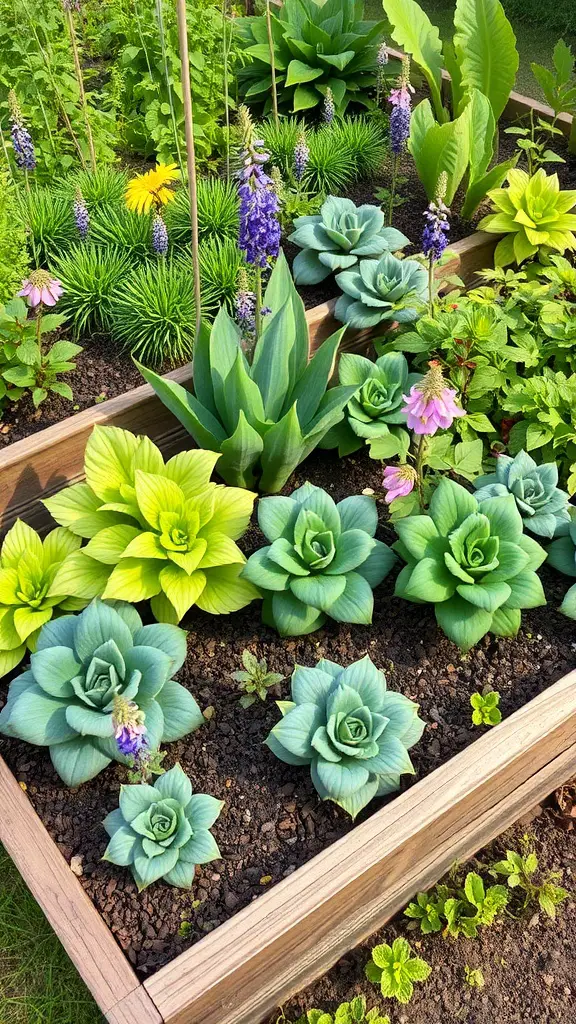
Companion planting is a smart way to boost your garden’s health and productivity. In the image, we see a vibrant raised garden bed filled with various plants. Each plant has its role, working together to create a thriving ecosystem.
For example, certain flowers attract beneficial insects while others repel pests. This natural balance helps keep harmful bugs at bay. In the raised bed, the colorful blooms not only add beauty but also serve practical purposes.
Mixing different types of plants can lead to better growth. Some plants, like the leafy greens shown, benefit from the shade provided by taller plants. This helps them thrive without getting scorched by the sun. It’s all about finding the right combinations.
Using companion planting strategies can also improve soil health. Plants like mint can help deter pests, while others may enhance nutrient uptake. This creates a more sustainable garden that requires less intervention.
Watering Techniques for Raised Beds
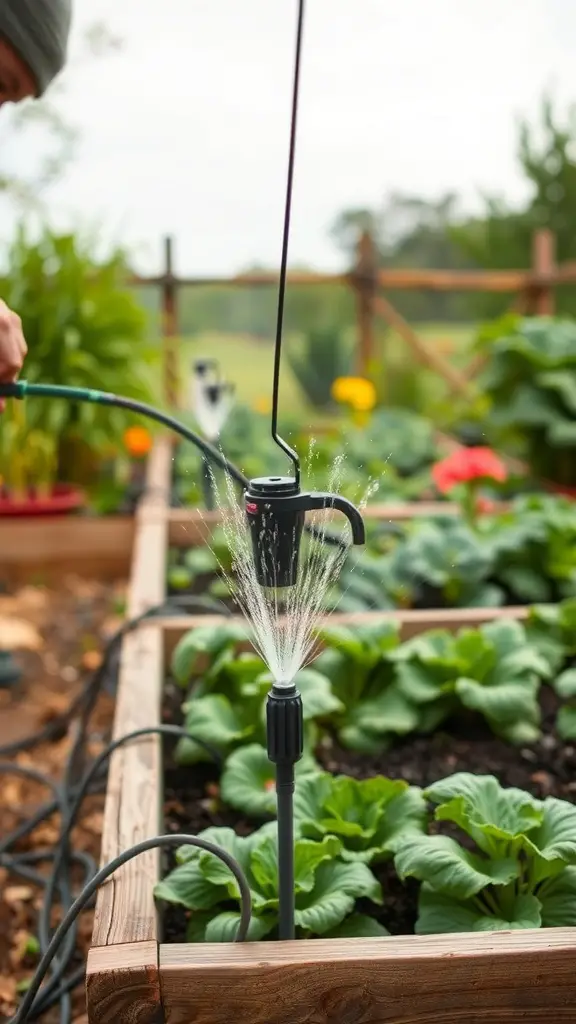
Watering raised garden beds can be a fun and rewarding task. The image shows a gardener using a hose attachment to water vibrant green plants nestled in a wooden bed. This method ensures that the plants receive just the right amount of moisture.
One effective technique is to use a drip irrigation system. This allows water to drip slowly at the roots, reducing waste and ensuring deep watering. It’s especially useful during hot days when plants need more hydration.
Another option is to use a soaker hose. This type of hose can be laid out on the soil surface or buried under mulch. It delivers water directly to the soil, keeping the leaves dry and minimizing the risk of disease.
Hand watering is also a great choice for smaller beds. It gives you control over how much water each plant gets. Just be sure to water early in the morning or late in the evening to prevent evaporation.
Lastly, consider using mulch to retain moisture in the soil. Mulch helps keep the ground cool and reduces the frequency of watering. With these techniques, your raised garden beds will thrive!
Designing Your Raised Bed Layout
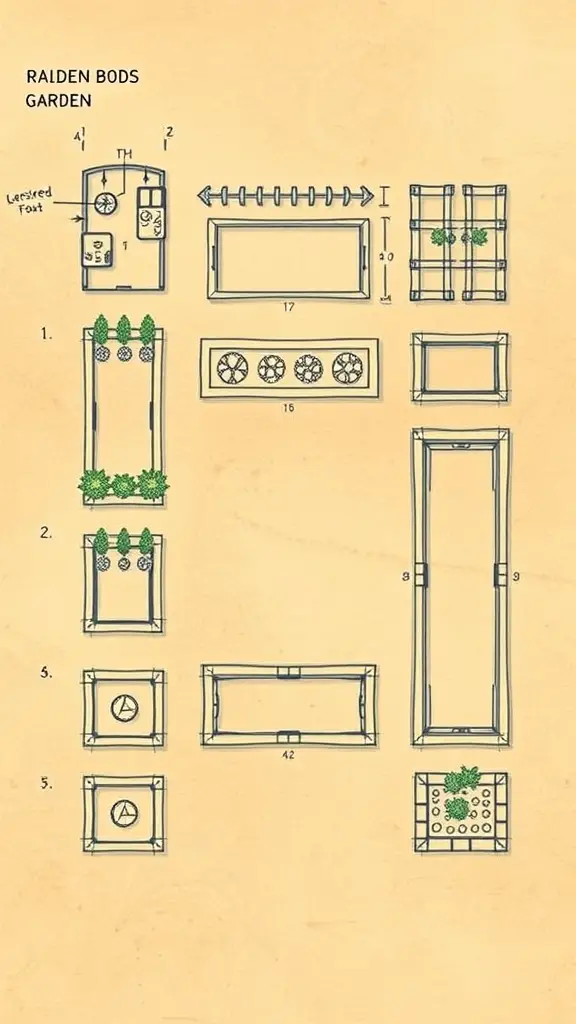
Creating a layout for your raised garden beds can be a fun and creative process. The image shows various designs for raised beds, each with unique shapes and arrangements. You can see rectangular and square beds, along with some circular options. This variety allows you to choose a layout that fits your space and gardening style.
When planning your layout, think about the size of your garden area. The designs in the image include different dimensions, so you can pick what works best for you. For instance, longer beds may be ideal for growing rows of vegetables, while smaller, square beds can be perfect for herbs or flowers.
Consider the sunlight and water access for each bed. Placing taller plants on the north side can prevent them from shading shorter ones. The image also suggests spacing between beds for easy access. This is important for maintenance and harvesting.
Lastly, don’t forget to have fun with your design! You can mix and match the shapes shown in the image to create a layout that is not only functional but also visually appealing. Happy gardening!
Materials for Building Raised Beds
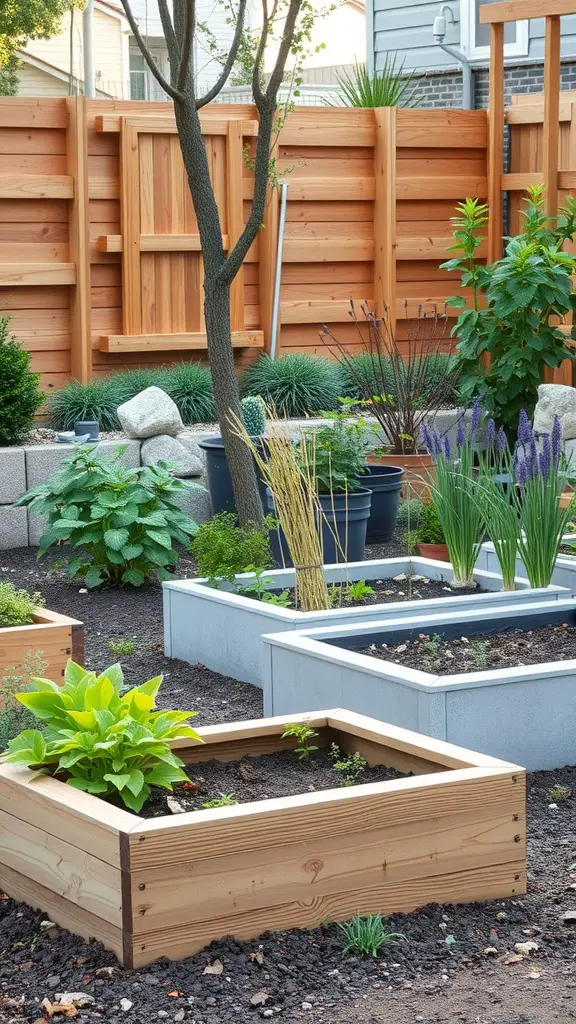
Raised garden beds are a fantastic way to grow your plants. They offer better drainage, improved soil quality, and easier access for gardening. When it comes to building these beds, the materials you choose can make a big difference.
In the image, you can see a lovely setup of raised beds made from wood and metal. Wood is a popular choice for its natural look and ease of use. Cedar and redwood are great options since they resist rot and pests. If you prefer a modern touch, metal beds can add a sleek look while being durable.
Another important factor is the soil mix. A good blend of compost, topsoil, and organic matter will help your plants thrive. Don’t forget to consider drainage too. Adding gravel at the bottom can prevent water from pooling.
Lastly, think about the design. You can create different shapes and sizes to fit your space. Whether you want a simple rectangle or a more intricate layout, the materials you choose will help bring your garden vision to life.
Mulching Techniques for Moisture Retention
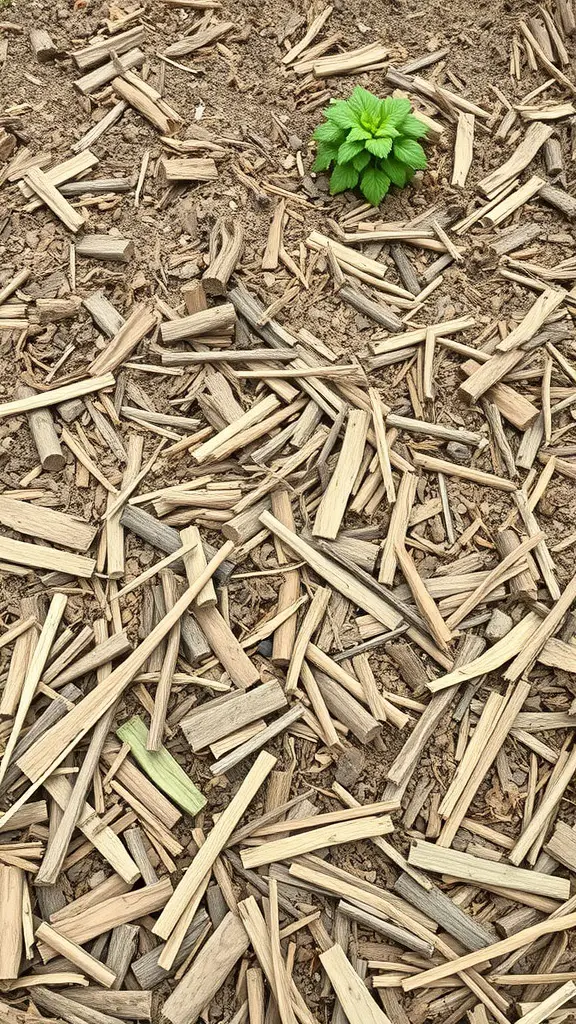
Mulching is a fantastic way to keep your raised garden beds thriving. In the image, you can see a layer of wood chips spread across the soil, with a small green plant peeking through. This setup not only looks neat but serves a vital purpose.
The wood chips act as a protective barrier. They help retain moisture in the soil, which is essential for healthy plant growth. When the sun beats down, this layer prevents evaporation, ensuring your plants get the water they need.
Using organic mulch, like wood chips, also adds nutrients back into the soil as it breaks down. This means you’re not just protecting your plants; you’re feeding them too. Plus, it can help suppress weeds, giving your plants a better chance to flourish.
So, if you’re looking to keep your garden beds healthy and productive, consider adding a good layer of mulch. It’s a simple yet effective technique that can make a big difference!
Incorporating Edible Flowers
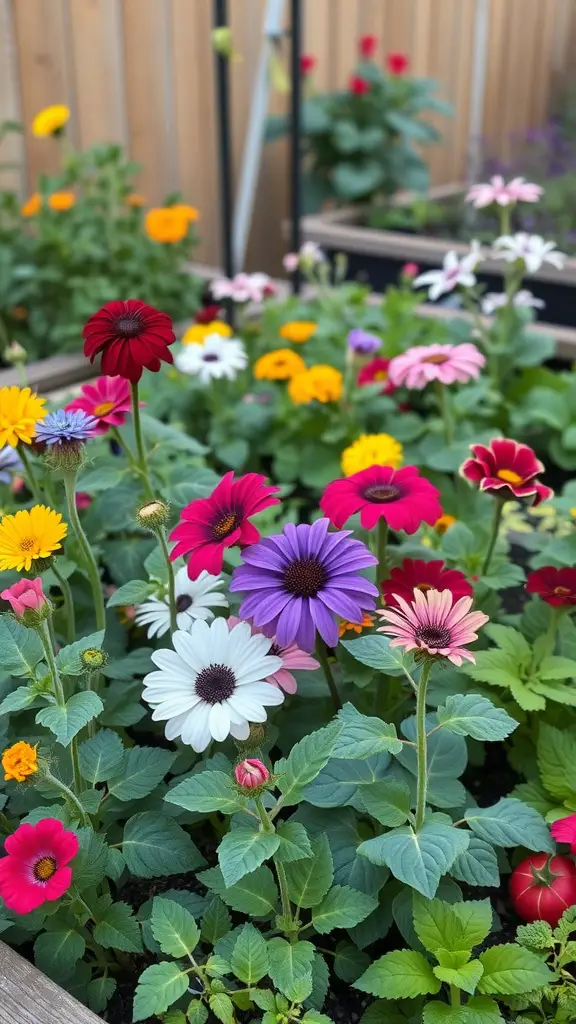
Raised garden beds are perfect for growing a mix of vegetables and flowers. The image shows a vibrant display of edible flowers, which can add color and flavor to your meals. Flowers like nasturtiums, pansies, and calendulas not only look beautiful but also taste great.
These flowers can be used in salads, as garnishes, or even in desserts. They bring a fresh twist to your dishes and can impress your guests. Plus, growing them in raised beds makes it easy to care for them while keeping your garden organized.
When planting, make sure to choose flowers that are safe to eat. Mixing them with your vegetables can attract pollinators, which is great for your garden’s health. So, don’t hesitate to add some edible blooms to your raised beds!
Vertical Gardening Solutions
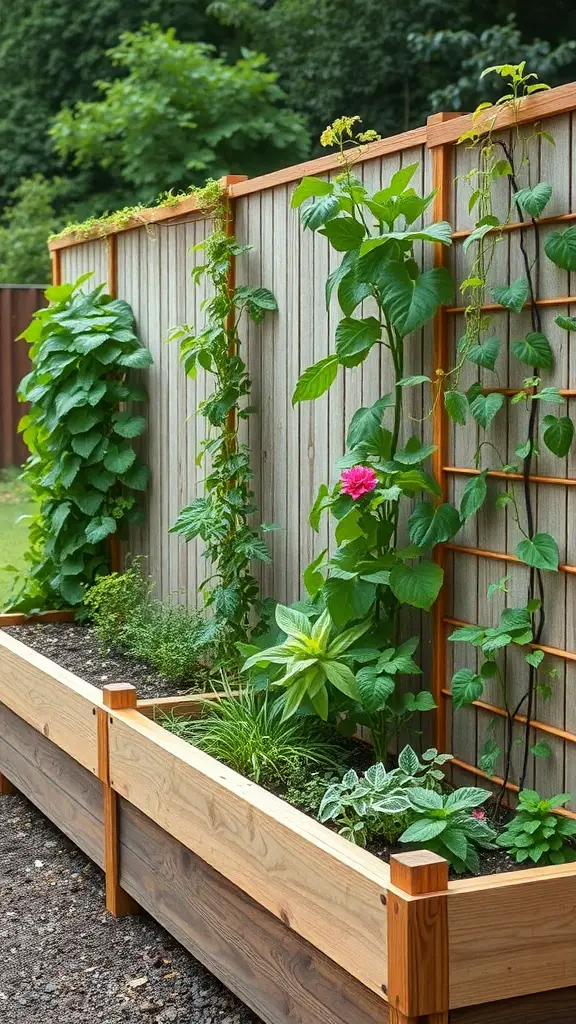
Vertical gardening is a fantastic way to maximize space in your raised garden beds. The image shows a beautiful setup where plants climb up trellises attached to a fence. This method not only saves ground space but also adds visual interest to your garden.
In the image, you can see various plants thriving vertically. The tall vines and colorful flowers create a lively atmosphere. This approach is perfect for small yards or urban settings where space is limited. By growing upwards, you can enjoy a lush garden without needing a large area.
Using vertical structures like trellises or fences allows plants to receive more sunlight and improves air circulation. This can lead to healthier plants and potentially better yields. Plus, it makes harvesting easier!
Consider incorporating herbs and smaller vegetables in your raised beds alongside climbing plants. This combination can create a diverse and productive garden. Vertical gardening not only enhances the beauty of your space but also makes gardening more accessible and enjoyable.
Winterizing Your Raised Beds
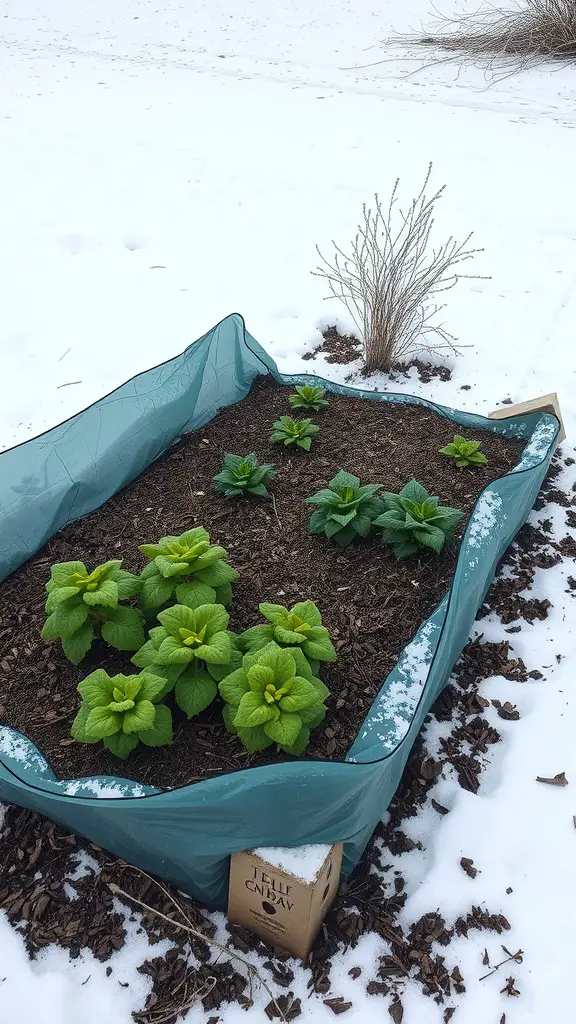
Winterizing your raised garden beds is a smart move to protect your plants and soil. In the image, we see a raised bed covered with a protective layer, surrounded by snow. This setup helps keep the soil temperature stable and shields the plants from harsh winter conditions.
First, consider adding a layer of mulch. This can help insulate the soil and retain moisture. The mulch also adds nutrients as it breaks down. You can use leaves, straw, or wood chips for this purpose.
Next, think about covering your plants. The image shows a green cover that provides protection from frost. This cover can help trap heat and keep the plants alive during colder months. Make sure it’s breathable to prevent mold.
Lastly, don’t forget to check your plants regularly. Even in winter, they need some attention. Look for signs of distress and adjust your care as needed. With these steps, your raised beds will be ready to thrive when spring arrives!
DIY Raised Bed Kits
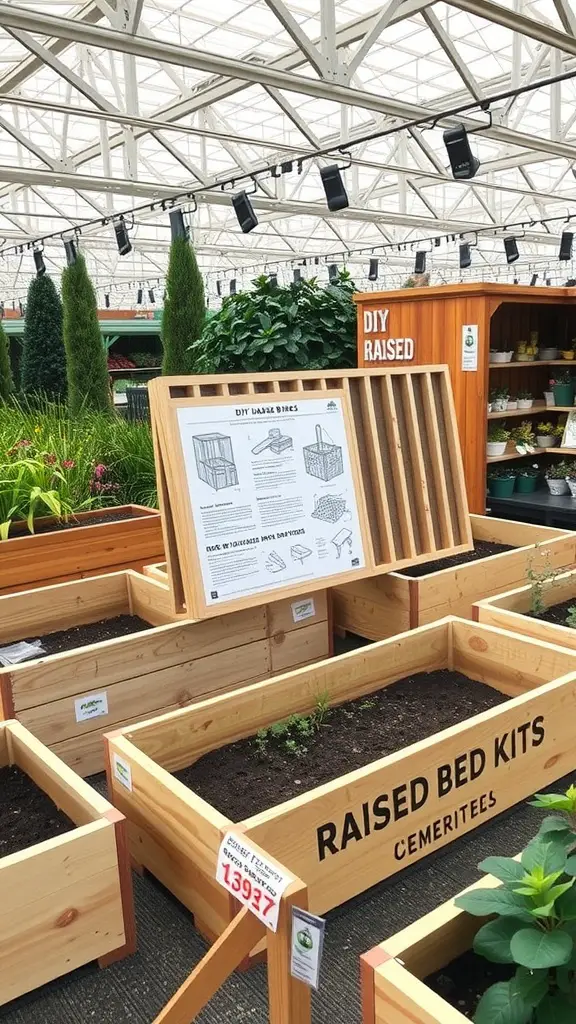
DIY raised bed kits are a fantastic way to start your gardening journey. These kits come with everything you need to create your own raised garden beds. The image shows a variety of wooden raised beds, neatly arranged and ready for planting.
Each kit typically includes pre-cut wood pieces, screws, and easy-to-follow instructions. This makes it simple for anyone, regardless of skill level, to assemble their own garden space. The raised beds in the image are labeled clearly, making it easy to identify them.
Using raised beds can improve drainage and soil quality, which is great for growing vegetables and flowers. Plus, they add a nice touch to your backyard or garden area. Whether you want to grow herbs, vegetables, or flowers, these kits can help you get started with minimal fuss!
Pest Management in Raised Beds
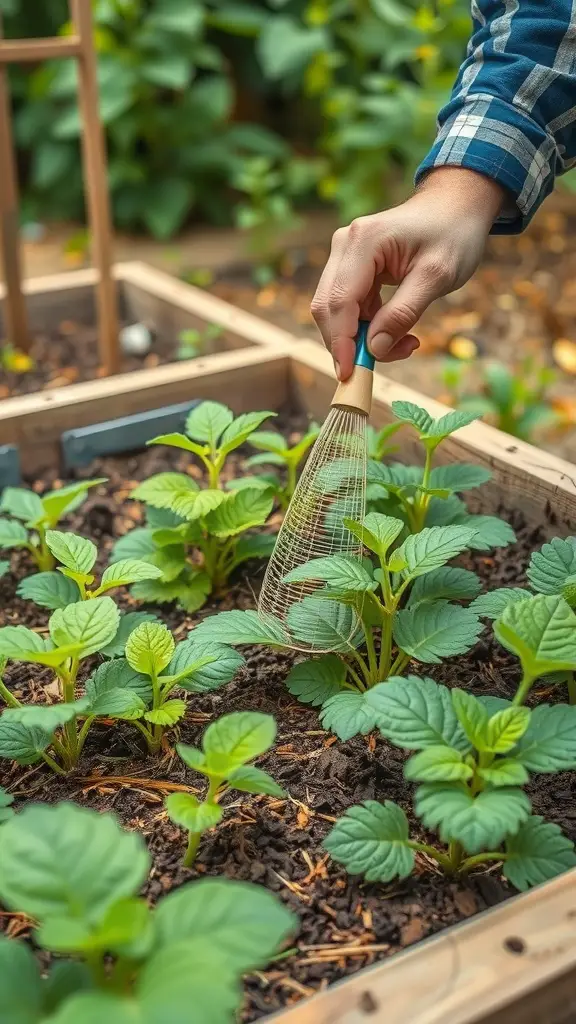
Pest management is a key part of keeping your raised garden beds thriving. In the image, we see a hand gently tending to young plants, which highlights the importance of hands-on care. Raised beds make it easier to spot and manage pests before they become a problem.
One effective method is to regularly inspect your plants. Look for any signs of damage or pests. Early detection can save your plants from serious harm. Using natural pest deterrents, like neem oil or insecticidal soap, can also help keep unwanted visitors at bay.
Companion planting is another smart strategy. Some plants naturally repel pests, while others attract beneficial insects. For example, marigolds can deter aphids, making them great companions for many vegetables.
Mulching is beneficial too. It not only retains moisture but can also prevent pests from reaching your plants. A layer of organic mulch can create a barrier that makes it harder for pests to invade.
Lastly, don’t forget about physical barriers. Using row covers or netting can protect your plants from larger pests like birds and rabbits. With these simple techniques, you can enjoy a healthy and productive raised garden.
Enhancing Soil Fertility Naturally
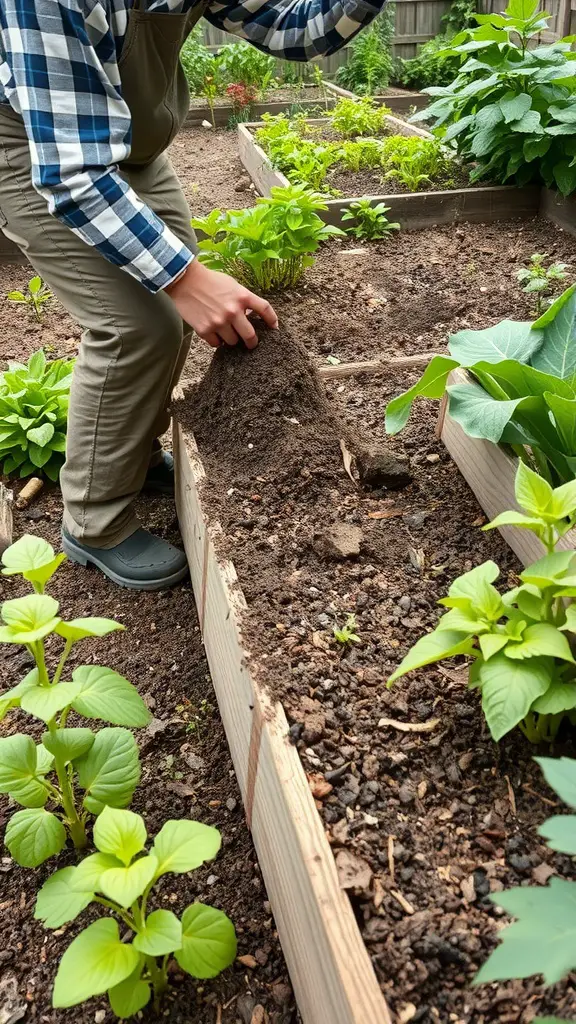
Raised garden beds are a fantastic way to grow plants while keeping soil health in check. In the image, someone is working in a garden bed, showing how hands-on gardening can be. The soil looks rich and dark, indicating good fertility.
Adding organic matter, like compost or aged manure, can boost soil nutrients. This practice not only feeds your plants but also improves soil structure. Healthy soil retains moisture better and promotes beneficial microorganisms.
The person in the image is likely preparing the soil for planting. This step is crucial for ensuring that plants have the best start possible. Regularly checking and amending the soil keeps it in top shape for future crops.
Using mulch around plants can also help maintain soil moisture and prevent weeds. It’s a simple trick that goes a long way in supporting plant health. Overall, enhancing soil fertility naturally leads to a thriving garden.
Using Raised Beds for Urban Gardening
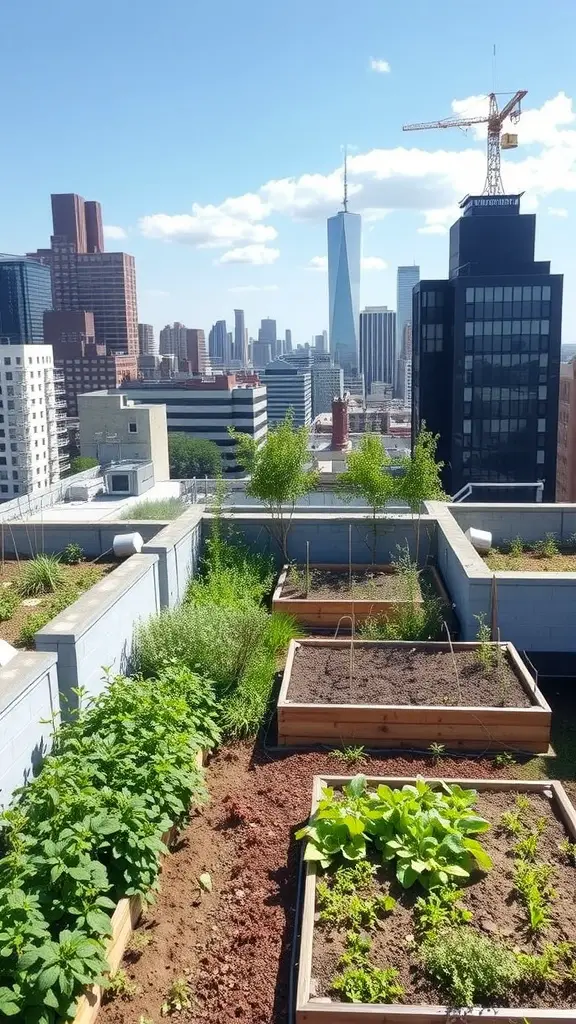
Raised garden beds are a fantastic way to grow plants in urban settings. They make gardening accessible even in small spaces, like rooftops or balconies. The image shows a vibrant rooftop garden with neatly organized raised beds, surrounded by a stunning city skyline. This setup not only maximizes space but also adds greenery to an otherwise concrete environment.
In urban areas, soil quality can be poor, and raised beds allow you to control the soil mix. You can fill them with nutrient-rich soil, ensuring your plants thrive. The beds in the image are filled with a variety of plants, showcasing how diverse your garden can be. From leafy greens to herbs, the possibilities are endless.
Another benefit of raised beds is that they can help with drainage. Urban gardens often deal with water pooling, but raised beds allow excess water to drain away, keeping roots healthy. Plus, they can be built to a comfortable height, reducing the strain on your back while gardening.
Gardening in raised beds also encourages better pest control. With plants elevated, it’s easier to spot and manage pests before they become a problem. This proactive approach keeps your plants healthy and your harvest plentiful.
So, whether you have a small balcony or a spacious rooftop, raised beds can transform your urban gardening experience. They bring nature closer to home and make gardening enjoyable and productive.
Managing Soil pH Levels
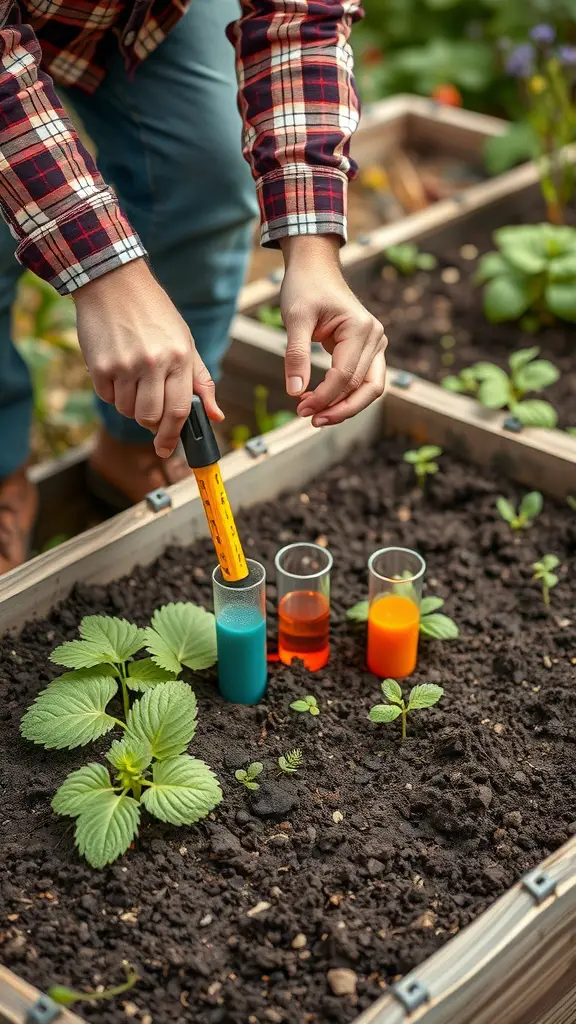
In the image, a person is testing the soil in a raised garden bed. They are using a pH meter, which is inserted into a test tube filled with soil. Nearby, there are colorful liquids in small test tubes, likely indicating different pH levels. This hands-on approach shows the importance of monitoring soil conditions for healthy plant growth.
Soil pH plays a big role in how well plants can absorb nutrients. If the pH is too high or too low, plants may struggle to thrive. Testing your soil regularly helps you understand its needs. You can adjust the pH by adding certain amendments, like lime to raise it or sulfur to lower it.
In a raised garden bed, managing soil pH is especially important. The contained environment means that nutrients can be depleted faster. Regular testing ensures that your plants get what they need to grow strong and healthy. So, grab that pH meter and keep an eye on your soil!
Using Raised Beds for Container Gardening
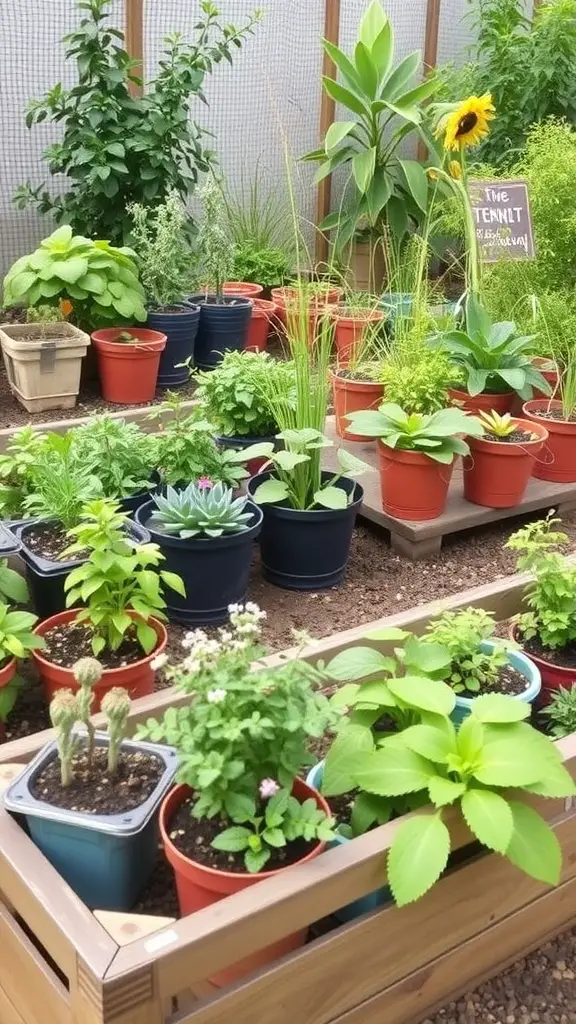
Raised beds are a fantastic option for container gardening. They provide a structured space that makes it easy to manage your plants. In the image, you can see a variety of plants in colorful pots, all thriving in a well-organized setup.
The raised bed design allows for better drainage and soil control. This means your plants can grow healthier and stronger. You can see herbs, flowers, and leafy greens all sharing the same space, which is a great way to maximize your gardening area.
Using containers in raised beds also makes it easier to move plants around as needed. If a plant isn’t thriving in one spot, you can simply relocate it. This flexibility is perfect for gardeners who want to experiment with different arrangements.
Another benefit is that raised beds can help keep pests away from your plants. The elevation can deter some critters, giving your plants a better chance to flourish. Plus, they look great! The colorful pots add a cheerful touch to any garden.
Creating a Pollinator-Friendly Garden
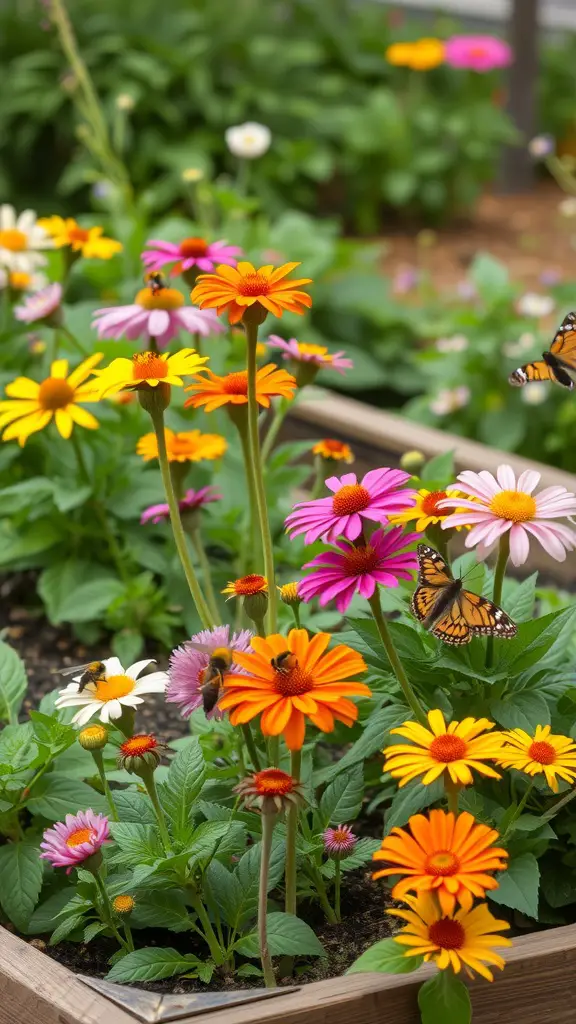
Raised garden beds can be a fantastic way to create a pollinator-friendly space. In the image, you can see vibrant flowers like daisies and coneflowers, which attract bees and butterflies. These creatures are essential for pollination, helping plants reproduce and thrive.
When designing your garden, think about including a variety of flowers that bloom at different times. This ensures that there’s always something for pollinators to enjoy. The colorful blooms in the image show how diverse your flower selection can be. Bright oranges, yellows, and pinks not only look beautiful but also draw in the insects you want.
Another tip is to avoid using pesticides. They can harm beneficial insects. Instead, focus on natural methods for pest control. Keeping your garden organic will help maintain a healthy ecosystem.
Lastly, consider adding some native plants. They are well-suited to your local environment and provide the best food sources for local pollinators. By creating a welcoming space, you’ll enjoy watching the busy bees and fluttering butterflies while contributing to the health of your garden and the environment.
Building Raised Beds on a Budget
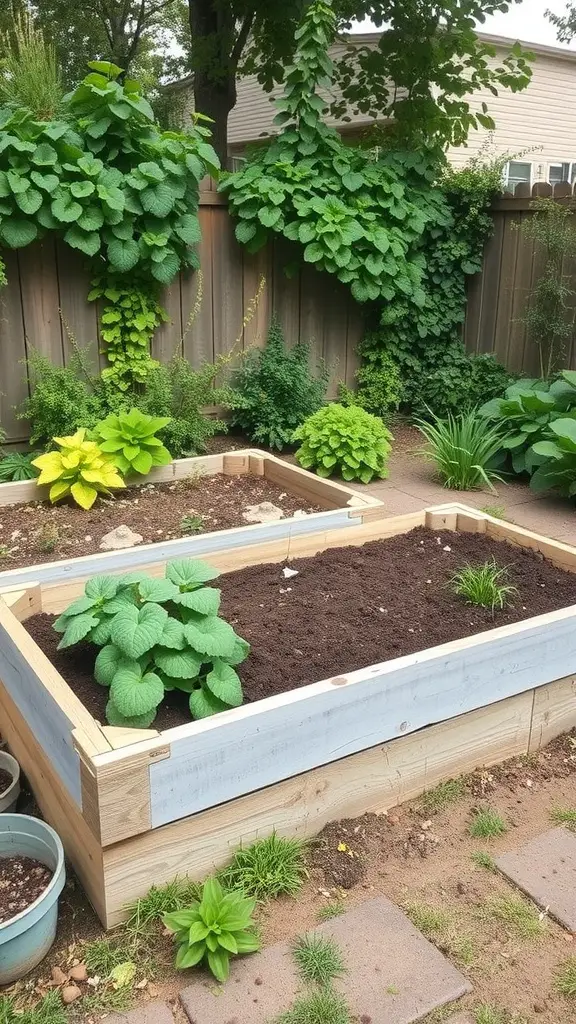
Creating raised garden beds doesn’t have to break the bank. The image shows a lovely setup with two wooden beds filled with rich soil, ready for planting. Surrounding them are vibrant green plants, adding a touch of life to the space.
To build your own raised beds, consider using reclaimed wood or pallets. These materials are often available for free or at a low cost. Just make sure the wood is untreated to avoid chemicals leaching into your soil.
Another budget-friendly option is to use concrete blocks. They are durable and can be arranged in various shapes. Plus, they can double as seating or plant holders.
Don’t forget about the soil! You can save money by mixing your own using compost and topsoil. This not only cuts costs but also enriches your plants’ growing environment.
With a little creativity and resourcefulness, you can create beautiful raised beds that enhance your garden without overspending. Happy gardening!
Integrating Drip Irrigation Systems
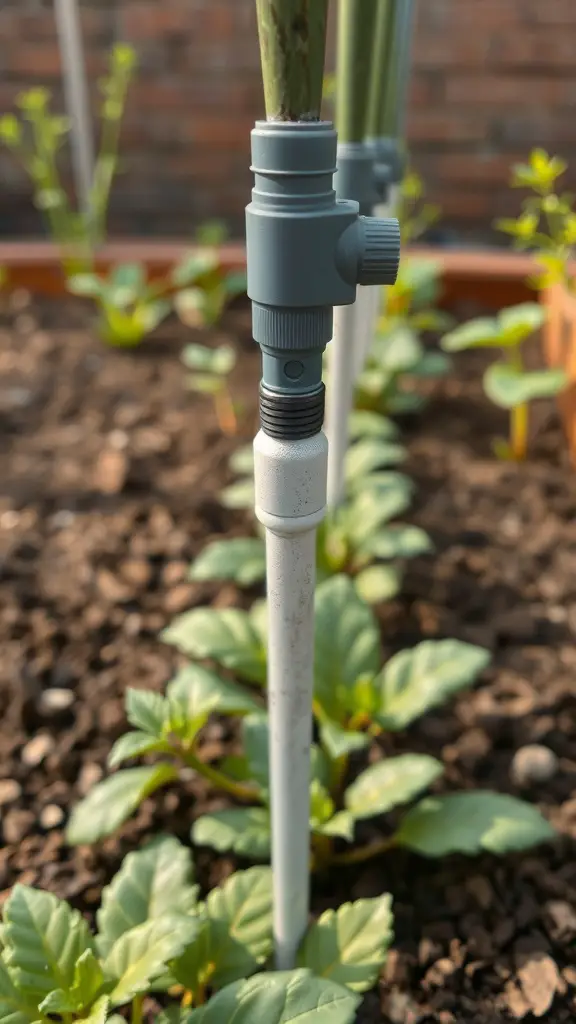
Drip irrigation is a fantastic way to keep your raised garden beds thriving. The image shows a close-up of a drip irrigation system, highlighting the components that help deliver water directly to the plants. This method minimizes water waste and ensures that your plants receive just the right amount of moisture.
In the picture, you can see a connector attached to a tube, which feeds water to the plants below. This setup allows for precise watering, making it easier to maintain healthy plants. The surrounding greenery indicates that the system is working well, providing the necessary hydration for growth.
Integrating a drip irrigation system into your raised garden beds can save you time and effort. Instead of watering manually, you can set up a timer and let the system do the work. This is especially helpful during hot summer days when plants need more water.
Overall, a drip irrigation system is a smart choice for anyone looking to enhance their gardening experience. It’s efficient, effective, and can lead to healthier plants and a more productive garden.
Selecting the Right Plants for Your Climate
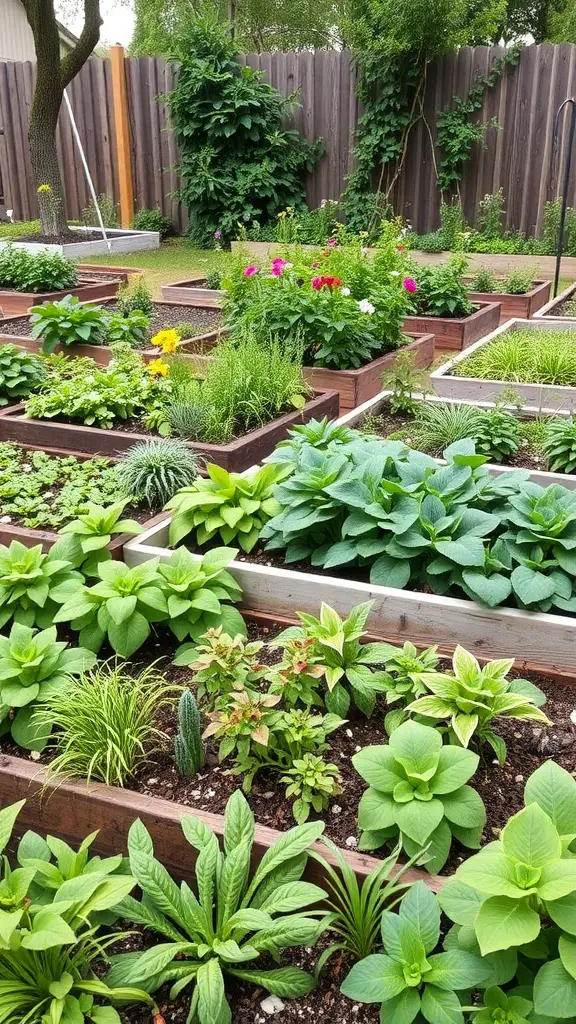
When planning your raised garden beds, picking the right plants is key. The image shows a vibrant garden filled with various plants, showcasing a mix of flowers and greens. This diversity not only adds beauty but also helps with pest control and pollination.
Start by understanding your climate zone. Some plants thrive in warm weather, while others prefer cooler temperatures. For example, herbs like basil love the heat, while leafy greens such as spinach do better in cooler conditions.
Next, think about your soil type. Well-draining soil is great for most plants, but some, like carrots, prefer a looser texture. The raised beds in the image appear well-maintained, which is essential for healthy growth.
Don’t forget about sunlight! Most vegetables need at least six hours of direct sunlight daily. Observe your garden area to see how the sun moves throughout the day. This will help you place your plants where they can thrive.
Lastly, consider companion planting. Some plants grow better together. For instance, tomatoes and basil are a classic combo. The colorful flowers in the image can also attract beneficial insects, making your garden a lively ecosystem.
Creating a Herb Garden in Raised Beds
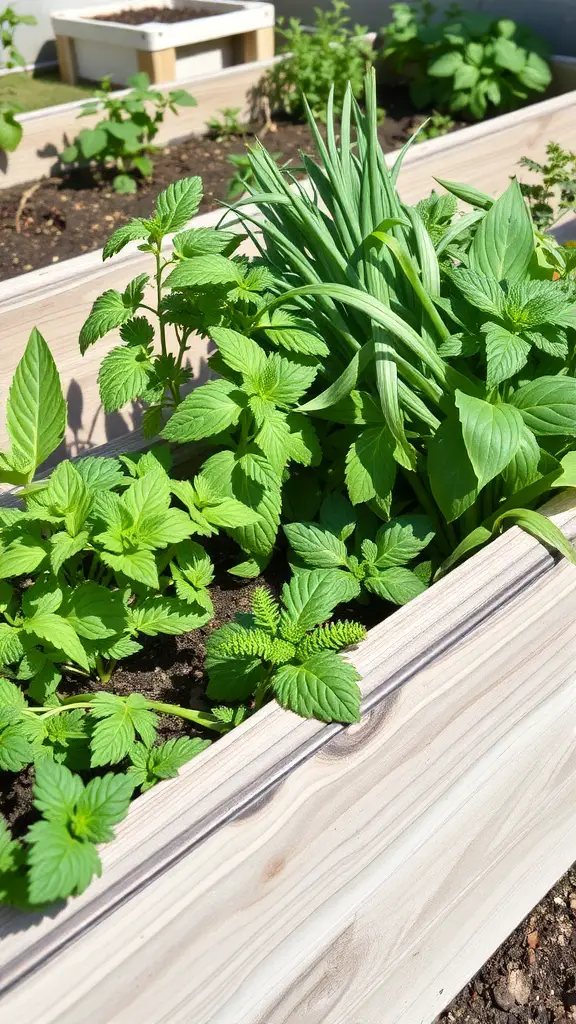
Raised garden beds are a fantastic way to grow herbs. They offer better drainage and soil quality, making it easier for your plants to thrive. In the image, you can see a vibrant mix of herbs, including mint and chives, all flourishing in their designated space.
Starting your herb garden in a raised bed is simple. First, choose a sunny spot in your yard. Most herbs love sunlight, so aim for at least six hours of direct light each day. Next, fill your raised bed with quality soil. A mix of compost and garden soil works well.
When planting, consider the space each herb needs. Mint can spread quickly, so give it room to grow. Chives, on the other hand, can be planted closer together. Regular watering is key, but avoid overwatering. Herbs prefer slightly dry conditions.
Don’t forget to harvest regularly! Snipping off leaves encourages new growth and keeps your plants healthy. Enjoy the fresh flavors in your cooking, and take pride in your homegrown herbs!
Maintaining Raised Beds Throughout the Season
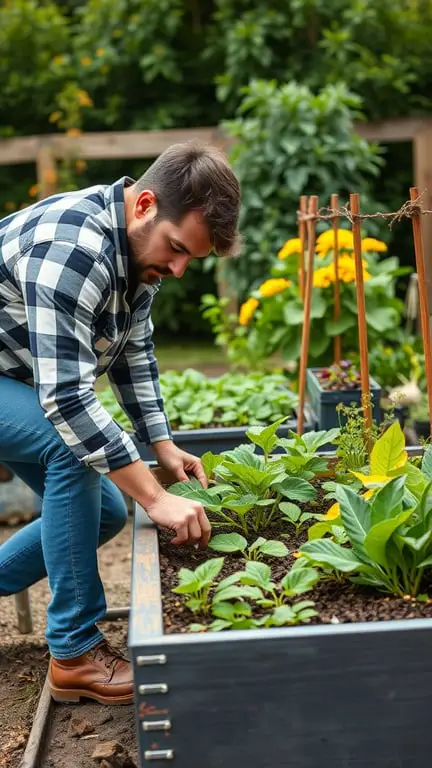
Raised garden beds are a fantastic way to grow plants and vegetables. They provide better drainage and soil quality, making it easier to maintain healthy plants. In the image, we see a gardener tending to her raised beds, surrounded by vibrant flowers and lush greenery. This scene captures the joy of gardening and the beauty of a well-kept space.
To keep your raised beds thriving, regular maintenance is key. Start by checking the moisture level of the soil. Raised beds can dry out faster than traditional gardens, so watering is essential, especially during hot days. A simple finger test can tell you if the soil needs water.
Next, keep an eye out for weeds. They can quickly take over if left unchecked. Pulling them out by hand is often the best method, especially when they are small. This helps your plants get the nutrients they need without competition.
Fertilizing your plants is also important. Using organic compost or a balanced fertilizer can boost growth. Just be sure to follow the instructions on the package to avoid over-fertilizing.
Lastly, don’t forget to enjoy the process! Gardening is not just about the end result; it’s about the experience. Take time to appreciate the beauty around you, just like the gardener in the image. Happy gardening!
Incorporating Garden Art in Raised Beds
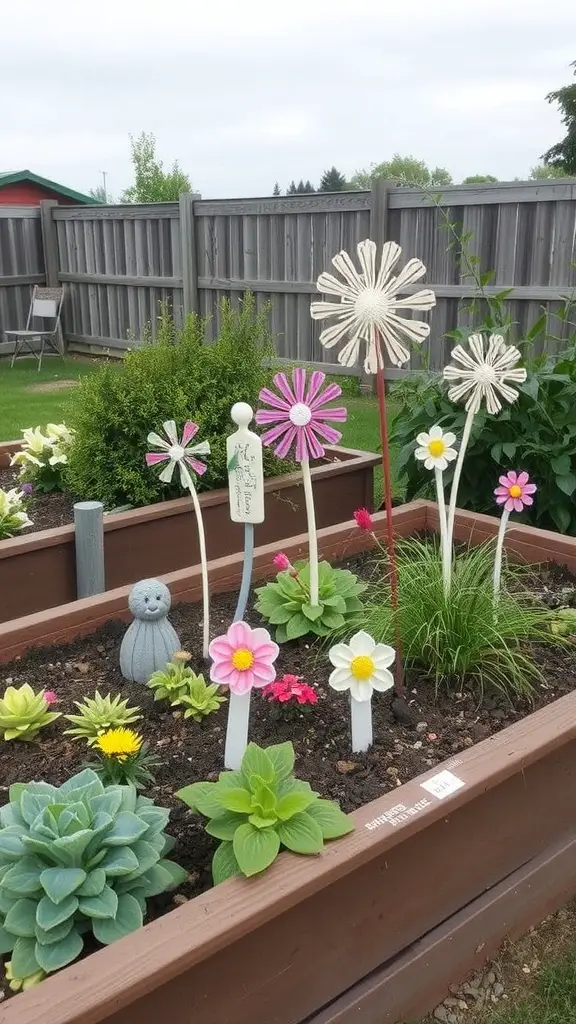
Raised garden beds are not just for growing plants; they can also be a canvas for creativity. Adding garden art can bring a fun and personal touch to your space.
In the image, colorful flower decorations stand tall among lush greenery. These cheerful pieces instantly brighten the garden and draw the eye. They create a playful atmosphere that invites you to enjoy the beauty of nature.
Consider using items like painted wooden flowers or whimsical sculptures. They can add character and charm, making your garden feel unique. You can even create DIY projects with your family for a personal touch.
Mixing art with plants can also help define spaces within your garden. Use taller pieces to create height and interest, while smaller decorations can fill in gaps. This combination can make your raised beds look more vibrant and inviting.
Using Raised Beds for Children’s Gardening
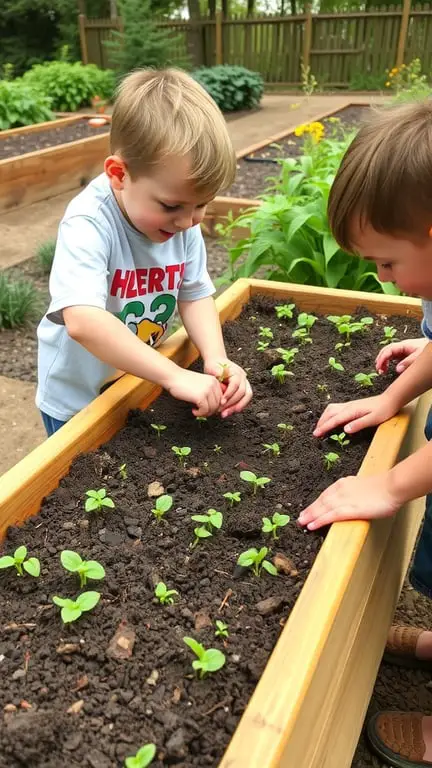
Raised garden beds are a fantastic way to introduce kids to gardening. In the image, you can see three children happily tending to their plants. They are engaged, focused, and learning about nature right in their backyard.
These beds are perfect for little hands. The height makes it easy for kids to reach the soil and plants without straining. This setup encourages them to get involved and take ownership of their gardening tasks.
Gardening teaches children valuable lessons. They learn about responsibility as they water and care for their plants. Watching seeds grow into vibrant vegetables or flowers brings a sense of accomplishment. Plus, it’s a fun way to spend time outdoors!
Using raised beds can also help keep the garden organized. Kids can easily see what they’ve planted and where. This clarity helps them understand plant growth cycles and the importance of spacing.
Overall, raised garden beds create a wonderful space for children to explore, learn, and enjoy the beauty of nature. It’s a simple way to spark their interest in gardening and healthy eating.
Exploring Different Raised Bed Heights
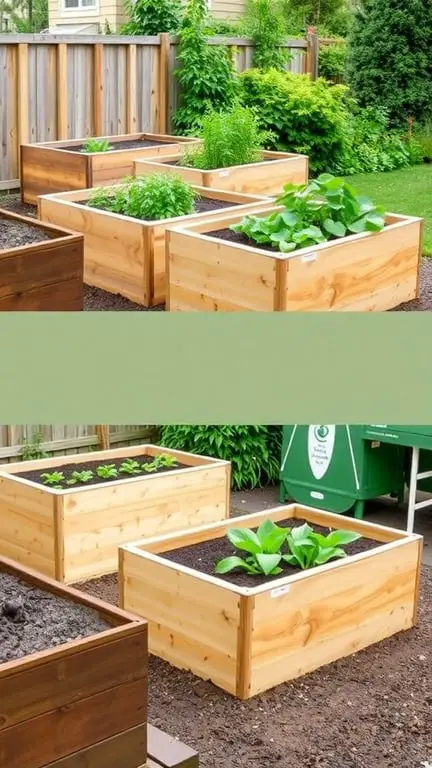
Raised garden beds come in various heights, each offering unique benefits. The image shows several raised beds of different heights, showcasing a neat and organized gardening space. These beds are perfect for growing vegetables, herbs, or flowers.
Shorter beds, around 12 to 18 inches high, are great for beginners. They are easy to reach and maintain. You can sit on the edge while planting or weeding, making gardening less strenuous.
Medium-height beds, usually around 24 to 30 inches, provide a comfortable working height. They are ideal for those who want to avoid bending over too much. This height is also suitable for a variety of plants, allowing for good drainage and root growth.
Taller beds, over 30 inches, are perfect for those who may have mobility issues. They allow for easy access without bending down. These beds can also be filled with a mix of soil and compost, promoting healthy plant growth.
Choosing the right height depends on your gardening needs and physical comfort. Each height has its perks, so consider what works best for you!
Sustainable Practices for Raised Bed Gardening
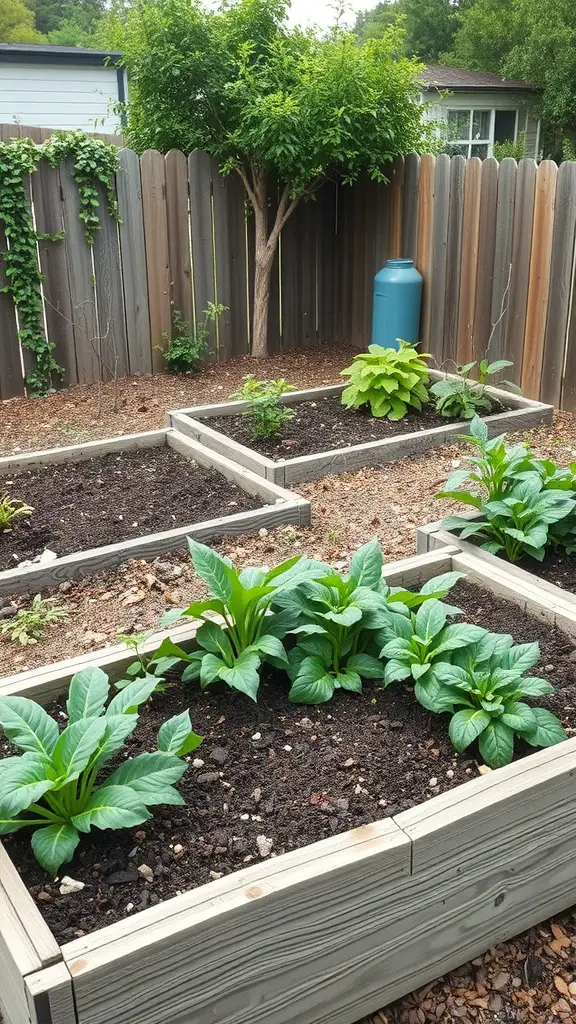
Raised garden beds are a fantastic way to grow your own food while being kind to the environment. The image shows a well-organized space with healthy plants thriving in wooden frames. This setup not only looks great but also offers several benefits.
Using raised beds helps with soil drainage and prevents soil compaction. The plants in the image appear lush and vibrant, indicating they are getting the right nutrients. You can fill these beds with a mix of compost and soil, which enriches the growing medium.
Water conservation is another advantage. The blue rain barrel in the background suggests a system for collecting rainwater. This practice reduces water waste and provides a natural source for your plants. It’s a simple step that can make a big difference.
Planting a variety of crops, as seen in the image, promotes biodiversity. This not only helps with pest control but also encourages a healthier ecosystem in your garden. Plus, it’s fun to experiment with different plants!
Finally, raised beds make gardening accessible for everyone. They can be built to a height that suits your needs, making it easier to tend to your plants without straining your back. Overall, raised bed gardening is a sustainable choice that benefits both you and the planet.
Harvesting Techniques for Raised Bed Crops
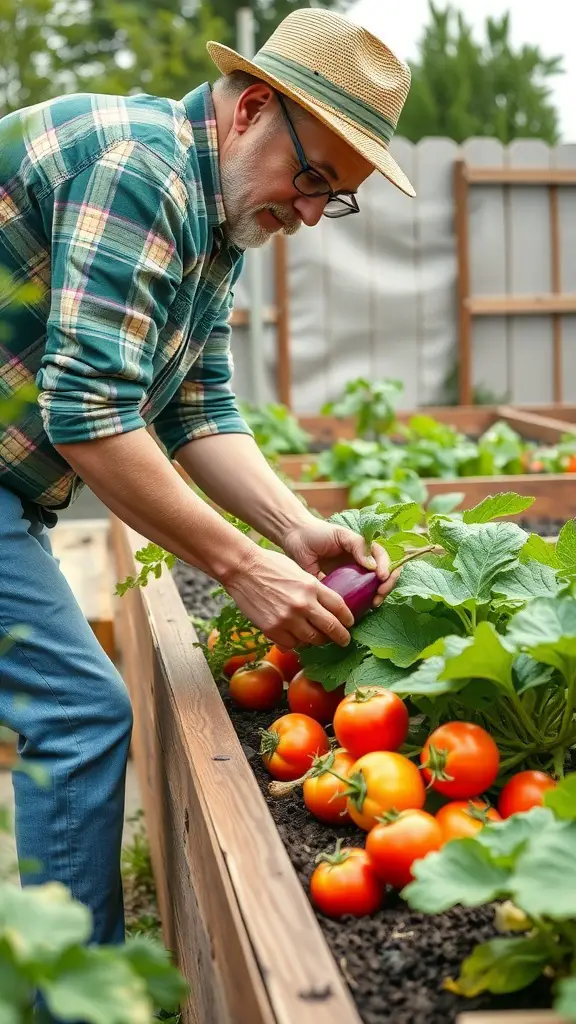
Harvesting from raised garden beds can be a rewarding experience. In the image, we see a gardener carefully picking ripe tomatoes and an eggplant. This hands-on approach is essential for ensuring that your crops are harvested at their peak flavor and freshness.
Timing is key when it comes to harvesting. For tomatoes, look for a deep red color and a slight give when gently squeezed. Eggplants should be shiny and firm, indicating they are ready to be picked. Using a sharp knife or garden shears can help you avoid damaging the plants.
Another technique is to harvest in the morning when temperatures are cooler. This helps preserve the quality of the produce. Always check for any signs of pests or disease while you’re in the garden, as early detection can save your crops.
Don’t forget to enjoy the fruits of your labor! Freshly harvested vegetables can be used in a variety of dishes, from salads to stews. Sharing your bounty with friends and family can make the experience even more enjoyable.
Creating a Wildlife-Friendly Garden
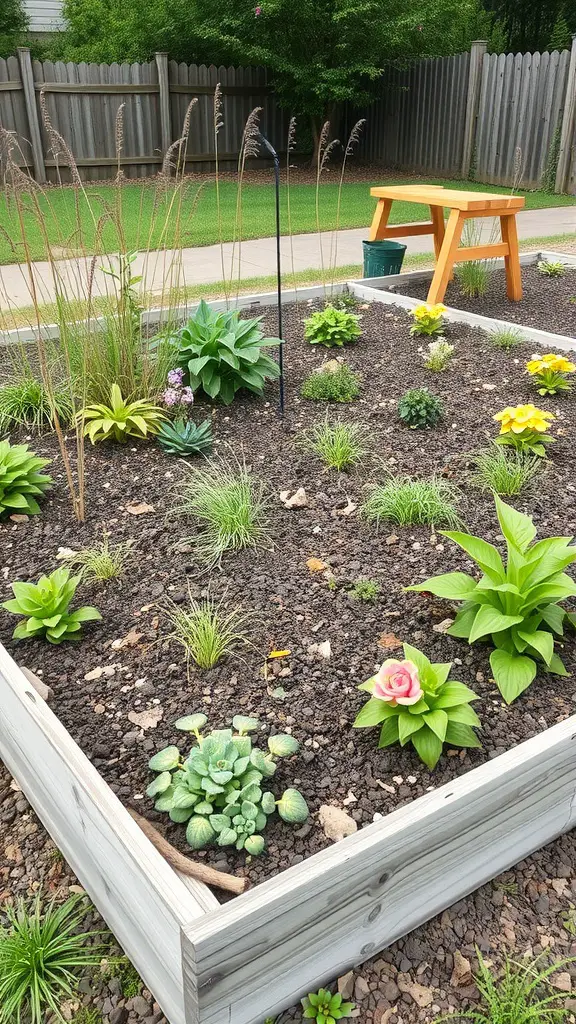
Raised garden beds are a great way to create a wildlife-friendly space in your yard. The image shows a well-maintained raised bed filled with various plants, providing a perfect habitat for local wildlife. The mix of greenery, including flowers and succulents, attracts pollinators like bees and butterflies.
Incorporating native plants is key. They not only thrive in your local environment but also support local wildlife. The plants in the image, with their vibrant colors and textures, can draw in beneficial insects and birds, making your garden a lively spot.
Adding features like a small water source or a bird feeder can enhance the wildlife experience. The bench nearby offers a cozy spot for you to enjoy the beauty of nature while observing the creatures that visit your garden.
Creating a wildlife-friendly garden is about balance. You want to cultivate a space that is both beautiful for you and inviting for wildlife. With a little planning and care, your raised garden beds can become a thriving ecosystem.
Documenting Your Gardening Journey
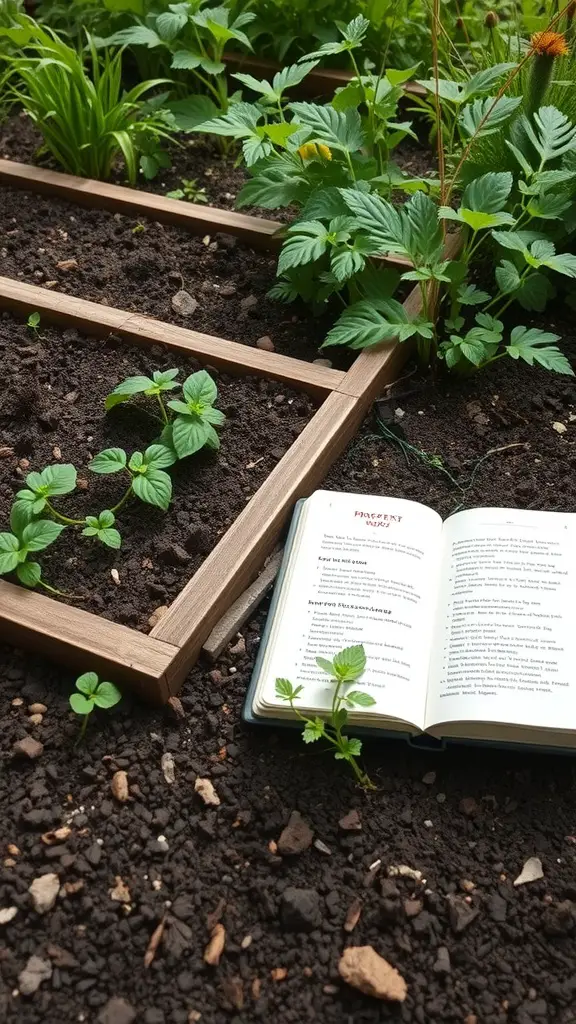
Raised garden beds can make your gardening experience more enjoyable and organized. In the image, you see a well-maintained raised bed with young plants peeking through the soil. This setup not only looks neat but also helps in managing soil quality and drainage.
Next to the bed, there’s an open notebook. This is a perfect tool for documenting your gardening journey. You can jot down notes about what you planted, when you planted it, and how it’s growing. Keeping track of your plants helps you learn and improve over time.
As you tend to your garden, take photos and write about your experiences. Whether it’s successes or challenges, every detail adds to your gardening story. This documentation can be a great way to reflect on your progress and share tips with fellow gardeners.
Exploring Raised Bed Gardening Communities
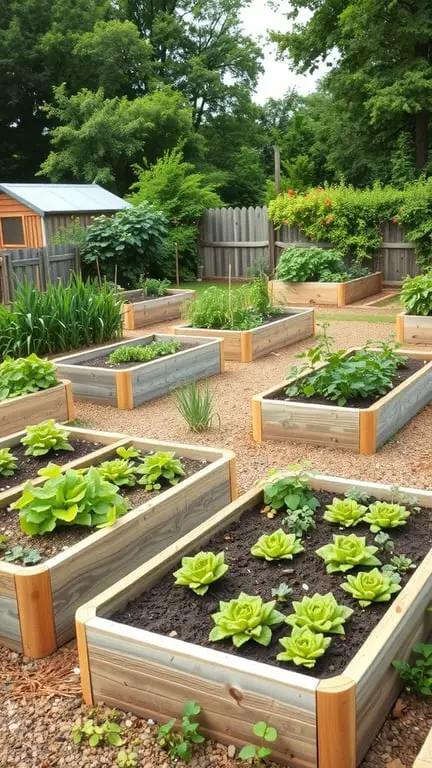
Raised bed gardening is more than just a way to grow plants; it’s a community experience. The image shows two people tending to their raised garden beds, surrounded by lush greenery. This scene captures the essence of collaboration and shared passion for gardening.
In these communities, gardeners come together to share tips, swap seeds, and celebrate their harvests. Raised beds make gardening accessible for everyone, whether you have a large yard or a small balcony. The neat arrangement of beds in the image highlights how organized and inviting these spaces can be.
Gardening in raised beds also promotes healthy soil and better drainage. This encourages plants to thrive, which is a common goal among community members. The joy of seeing your plants grow is often shared among friends and neighbors, creating bonds that go beyond just gardening.
Joining a raised bed gardening community can be a rewarding experience. You’ll find support, inspiration, and a chance to learn from others. Plus, there’s nothing quite like enjoying the fruits of your labor together!
